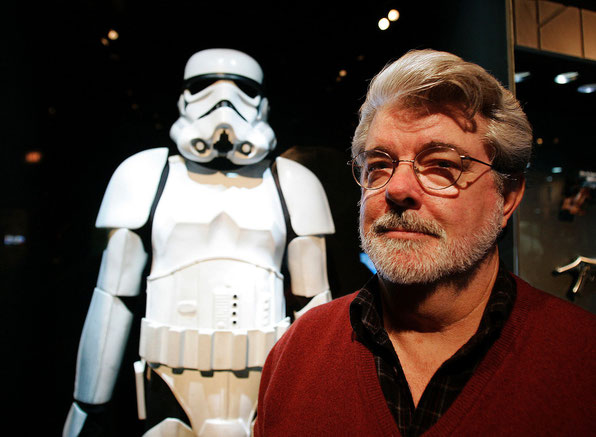George Lucas has retired apparently. Having sold his empire to Disney making him wealthier than a barely developed principality with minimal infrastructure, we are now being treated to phase two in the Lucas mid-life crisis.
When I first heard that Norman Rockwell, foremost painter of post war Americana was being placed alongside original ‘Star Wars’ miniatures and props it made no sense. Rockwell was known for capturing perfect moments in life which told a story or narrative beyond the confines of the frame. How could Lucas have the temerity to place his work alongside that of a real artist?

Informally known as ‘The Lucas Museum of Narrative Art’, it will be situated in Chicago, cost one billion dollars to build, have a further four hundred million dollars left in trust by Lucas after his death and be an eternal monument to one man’s search for artistic validation. You see my contention is similar to one made by Peter Biskind in ‘Easy Riders and Raging Bulls’. George Lucas is a serious film maker with a ‘blockbuster’ mentality. According to some, financial independence from the studios has cost Lucas his artistic integrity, which he is attempting to claw back by erecting this tourist attraction soon to be dubbed ‘The ‘Star Wars’ Museum’.
Joe Eszterhas once said of the man that his one true talent lay in making money, suggesting that Lucas was creatively barren. You see I like Eszterhas and agree in part with his statement, but have issues with the implication. After all it was Lucas who came up with the concept for ‘Indiana Jones’ as a Saturday afternoon matinee idol, suggested ‘McGuffins’ for all four films and spearheaded effects house ‘Industrial Light and Magic’. He also backed Steven Spielberg when Universal had concerns about hiring him for ‘Raiders’ and has stuck around ever since. Consider also the part he played in developing digital film making and archiving techniques and suddenly Eszterhas’ implication begins to unravel.
Now it is true that beyond ‘Star Wars’ the Lucas back catalogue has been patchy. There was ‘Willow’ with Val Kilmer and Warwick Davis, ‘Howard the Duck’ about, well a talking duck and finally World War II flick ‘Red Tails’. These movies represent the stick which media groups have beaten Lucas with for years, because nothing makes better headlines than bad box office. Unfortunately what people choose to forget are his early films.
‘THX 1138’ is based on a story by science fiction writer Ray Bradbury, starred Robert Duvall and was Lucas’s first film. Similar to Orwell’s ‘1984’ it depicts a society where sexual intimacy is illegal and the needs of the individual are considered irrelevant. This could not be further away from the numerous sequels which would come to define Lucas in later life. Here is a film maker passionate, creative and clearly talented. Having said that ‘THX’ which Lucas named his surround system after is not for everyone. A touch slow and overly long, it was still considered to be solid work, helping to fund screenwriter and friend John Milius while he wrote ‘Apocalypse Now’.
‘American Graffiti’ on the other hand is a coming of age film set in the fifties which gave breaks to a young Harrison Ford, Richard Dreyfuss and Ron Howard. Similar in tone to Rob Reiner’s ‘Stand By Me’ and eighties television show ‘Happy Days’, it also has elements of Coppola’s ‘The Outsiders’, ‘Diner’, and ‘Rumblefish’. Unfortunately these early movies would be quickly forgotten when his next project made film history.
For many the combined release of ‘Star Wars’ and ‘Jaws’ signalled the end for cinema. Thankfully over thirty years later film shows no signs of dying off. Television streaming may now be the norm, production values and budgets for small screen dramas may have hugely improved, but film still prevails. Independent productions as well as big budget franchises are managing to co-exist while the Lucas legacy carries on ticking over.
In creating and defining the ‘blockbuster’ George Lucas has influenced generations. Without it there would be no effects houses, no digital cinema, or dare I say it no motion capture ‘volumes’. Movies in terms of entertainment would still exist without doubt, but film in all its forms and variations may well have remained static. Lucas has earned his right to sit alongside Rockwell in the halls of narrative history. His financial freedom burden or otherwise has pushed the medium forward. His desire and passion for film has been channelled into related fields beyond the production of an end product. For this reason he should ignore the naysayers, backbiters and gossip columnists who devalue his contribution at every turn. Make no mistake this is not just a serious filmmaker, here is a man serious about film.



